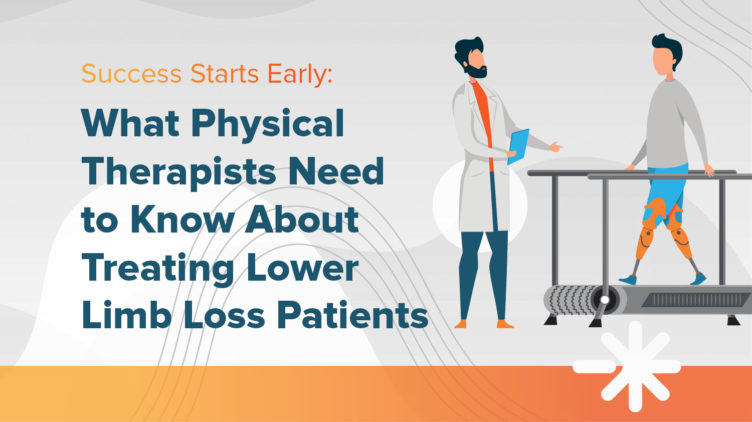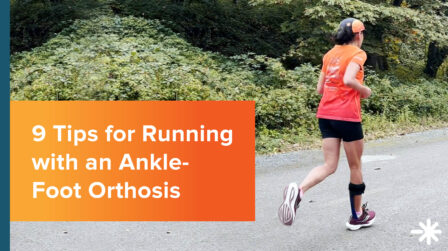Success Starts Early: What Physical Therapists Need to Know About Treating Lower Limb Loss Patients

Physical therapists who encounter lower limb amputees in the acute or in-patient hospital rehabilitation setting play an important role in laying a solid foundation for the long-term success of their patients. The work they do early-on has the ability to shape their patients’ outcomes and positively impact their overall quality of life. Here’s how physical therapists can ensure they have the right systems in place to deliver the best results for their patients.
In our line of work, time can work for us or against us. What we, as physical therapists, are doing to improve recovery and minimize deconditioning immediately following amputation surgery can be extremely helpful in ensuring positive outcomes for our patients.
It has been well established that restoring and maximizing mobility increases the overall quality of life and satisfaction for patients with lower limb loss, which suggests that the sooner we get patients into a prosthesis, the better. Therefore, everything that is accomplished before an amputee receives their prosthesis contributes to long term success, emphasizing the pre-prosthetic phase of rehab.
Physical therapists are often uniquely positioned to help make certain that the right systems are in place to ensure continuity of care from the outset. This entails having a good team in place, including all healthcare providers involved in the patient’s care (physicians, prosthetists, social workers, etc). We also need to make sure the patients aren’t simply confined to a wheelchair while awaiting the receipt of their prosthesis as this will negatively impact their recovery once they do receive their prosthesis. This sedentary existence would ultimately prolong or increase their rehab timeline.
Meet the Author
Jason Meints, PT, DPT, is a physical therapist who specializes in the rehabilitation of amputees. He assists in the development and advancement of the rehab programs used at Hanger Clinic.

Here are four things you can focus on to set your limb loss patients up for success:
1. Know the Basics
The more you know, the better care you can provide. Establish a good working relationship with your patient’s prosthetist, and get to know the common nomenclature used in the prosthetic setting.
Spend some time with a prosthetist while they are seeing patients and invite them to join your treatment sessions. Understand how they view things. Learn how the patient impacts the prosthesis vs. how the prosthesis impacts the patient, so you can help bridge the gap. Start picking up on the language used in the clinic and use it to create stronger connections between yourself, your patient, and the prosthetist.
Even though you won’t be selecting specific brands and products, collaboration with the prosthetist will ensure that the prosthesis will meet the functional demands of your patient. Knowing what technology is available in terms of designs, sockets, suspension systems, feet, and knees based on K-levels could impact your patient’s outcomes. Technology allows us to do so much and ensuring your patient has the right components could be critical to maximizing their mobility.
2. Establish a Structured Pre-Prosthetic Program
This is an important stage of the prosthetic journey because it shapes the patient’s future outcomes and gives us a good idea of where they are going to be functionally.
A good pre-prosthetic program focuses on six main areas:
- Minimizing contractures and normalizing mobility/range of motion
- Developing a baseline of strength
- Progressing motor control through the neurodevelopmental sequence
- Treating the whole patient, not just the amputation
- Limb shaping, desensitization, and pain management
- Cardiovascular conditioning
If we can successfully meet these criteria in the pre-prosthetic phase, we can maximize their functional potential in the prosthetic training phase of their rehab.
3. Establish a Structured Prosthetic Training Program
The key to a successful prosthetic training program is to focus on quality movement and instilling good habits early on. This includes:
- Ensuring the patient can don and doff their prosthesis
- Ensuring the patient can manage their prosthesis (proper fit, hygiene)
- Establishing a proper center of balance and posture, minimizing compensations
- Emphasizing prosthetic stance control with single-leg activities, which is key to a quality gait pattern
- Pre-gait training to break down the gait pattern and improve motor control
- Progression into specific gait training techniques
- Functional training (ramps, stairs, uneven terrain, floor transfers)
If you follow these basics/fundamentals, then the specifics of gait training should be easy. Symmetry between the prosthetic limb and sound limb will create a more normalized gait pattern. Assess cadence, gait speed, and trunk control issues while the patient is ambulating. Try to minimize gait deviations by focusing on one thing at a time (knee control, step length, etc.) and then go back to gait analysis to see if it was effective. If so, then you can move on to another gait deviation or higher-level activities like stairs, ramps, on and off the floor, and making sure they are comfortable in their environment (work, home, etc).
4. Understand Prosthetic Goals
This goes back to establishing a good working relationship with the prosthetist and knowing prosthetically what they are trying to accomplish. With this knowledge, you will be better equipped to intervene when a prosthetic issue arises and the prosthetist isn’t immediately available. For example, if your patient is experiencing pain around a bony prominence, you may be able to place temporary pads adjacent to that area to help offload some of that pressure.
If you take anything away from this article, it’s that success starts early. Start by getting to know your prosthetist and prosthetic technology and then move on to establishing structured pre- and post-prosthetic programs. Make sure there is congruity between all phases of rehab, from acute care through outpatient. Remember, time can work for us if we have the right program in place to deliver optimal results.
Jason Meints, PT, DPT, developed this post in collaboration with Darren Stoop, PT, DPT, NSCA-CPT. Both are physical therapists for Hanger Clinic in Omaha, NE.
Connect With a Hanger Clinic Prosthetist
If you are interested in establishing a relationship with a prosthetist in your area, we’d love to connect with you to see how we can work together.
Latest Updates
Subscribe to stay up-to-date on our latest posts.



